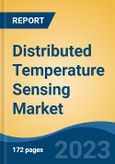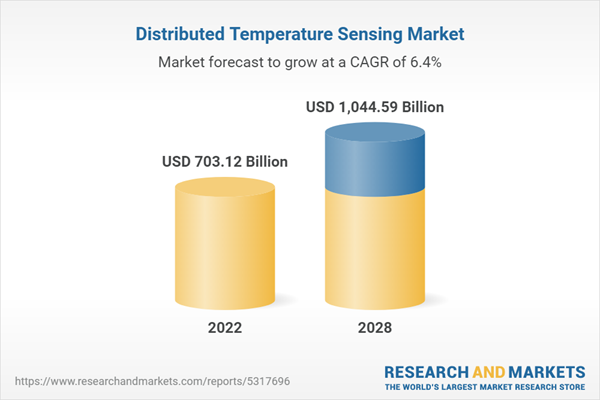Free Webex Call
Global Distributed Temperature Sensing Market is driven by the rising demand for safety and security in the oil & gas sectors. This growth is on account of the new technological advancements with the rapid development in detection of very small changes in the temperature in the forecast years. The Distributed Temperature Sensing (DTS) is basically used for the measurement of temperature across several fiber optic applications using optical fiber cables. Numerous advantages of DTS system include resistance to ionizing radiation, compact size, and insusceptibility to electromagnetic interference. These advantages have boosted their usage for sensing and measuring temperature across different applications, such as oil & gas, power & utility, and others. Speak directly to the analyst to clarify any post sales queries you may have.
10% Free customizationThis report comes with 10% free customization, enabling you to add data that meets your specific business needs.
Distributed temperature sensing is an emergent technology; therefore, its implementation across water-based applications has increased in the past years. A wide range of geophysical methods are being considered for monitoring hydrologic processes at large scales and the catchment. The demand for various geophysical methods is rising rapidly, in order to quantify the instabilities between surface water and groundwater. All these factors are projected to contribute to the rising adoption of DTS.
By directing a laser light along the fiber-optic cable, the DTS through fiber optics is transmitted. The incident light scatters as a result of photons' interactions with the chemical structures of the fiber. Temperature is measured using the variation in optical powers that has been observed. In hydrologic processes, the distribution temperature sensing is employed in a variety of applications, including determining transmissive fractures in bedrock boreholes and evaluating the interaction of a stream and an estuary in the aquifer.
Increasingly, groundwater discharge zones are being identified by the use of distributed temperature sensing to track temperature variations in the stream bed. Additionally, downhole temperature can be monitored with distributed temperature sensing to examine hydrogeological processes with high spatial and temporal frequency. The use of these sensors in passive mode for on-site groundwater flow, in-well flow, and subsurface thermal property assessment is also becoming more common. Such factors are significantly boosting the utilization of distributed temperature sensors, which is fuelling market expansion.
Need for Enhanced Safety at any Industrial Workplace is Fuelling the Market Growth
The petroleum industry has been witnessing consistent growth for the past few decades. Over a period, advanced technological instruments are introduced invarious industries such as oil & gas, power monitoring, etc., to increase production, which has created a huge demand for safety and security at the workplace. Moreover, due to this increased demand for sensing in harsh environments with high pressure and temperature, the distributed temperature sensing market is expected to witness continuous growth in the coming years.Increasing Proliferation of Optic Fiber Sensing Cable is Driving the Market Growth
Rising demand for temperature sensing with high accuracy and very high response time is going to increase the need for optic fiber-based temperature sensing systems. The high production of fiber cables for sensing applications is going to increase the distributed temperature sensing market in the forthcoming years. These fiber optic sensors are appropriate for rough conditions including high vibrations, noise, extreme heat, unstable and wet environments.High Productivity in the Ever-growing Applications is Driving the Market Growth
The demand for high productivity of fiber optic-based sensors is increasing due to the rise in the requirement for temperature sensing over longer distances with larger surface areas. Many industries like subsea, marines etc., are still growing that increases the need for more accurate detection of even the small change in temperature. This increase in the applications of temperature sensing is going to boost the global distributed temperature sensing market in the forecast years.Market Segmentation
Based on Operating Principle, the market is fragmented into Optical Time Domain Reflectometry and Optical Frequency Domain Reflectometry. Based on Fiber Type, the market is segmented into Single-Mode Fiber and Multi-Mode Fiber. Based on Application, the market is separated into Oil & Gas, Power Cable Monitoring, Process & Pipeline Monitoring, Fire Detection and Environmental Monitoring.Company Profiles
Baker Hughes Company, Schlumberger Limited, LIOS Technology GMBH, Halliburton Company Corporation, Yokogawa Electric Corporation, AP Sensing GmbH, Bandweaver Technologies Pvt. Ltd., Sensornet Limited, Sumitomo Electric Industries, Ltd., Weatherford International plc are among the major market players in the global platform that lead the market growth of the global Distributed Temperature Sensing market.Report Scope:
In this report, the Global Distributed Temperature Sensing Market has been segmented into the following categories, in addition to the industry trends which have also been detailed below:Distributed Temperature Sensing Market, By Operating Principle:
- Optical Time Domain Reflectometry
- Optical Frequency Domain Reflectometry
Distributed Temperature Sensing Market, By Fiber Type:
- Single-Mode Fiber
- Multi-Mode Fiber
Distributed Temperature Sensing Market, By Application:
- Oil & Gas
- Power Cable Monitoring
- Process & Pipeline Monitoring
- Fire Detection
- Environmental Monitoring
Distributed Temperature Sensing Market, By Region:
- North America
- United States
- Canada
- Mexico
- Europe
- Germany
- United Kingdom
- France
- Russia
- Spain
- Asia-Pacific
- China
- India
- Japan
- South Korea
- Australia
- Middle East & Africa
- UAE
- Saudi Arabia
- South Africa
- South America
- Brazil
- Argentina
- Colombia
Competitive Landscape
Company Profiles: Detailed analysis of the major companies present in the Global Distributed Temperature Sensing market.Available Customizations:
With the given market data, the publisher offers customizations according to a company’s specific needs.This product will be delivered within 1-3 business days.
Table of Contents
1. Product Overview2. Research Methodology3. Impact of COVID-19 on Global Distributed Temperature Sensing Market4. Executive Summary5. Voice of Customers15. Strategic Recommendations
6. Global Distributed Temperature Sensing Market Outlook
7. North America Distributed Temperature Sensing Market Outlook
8. Europe Distributed Temperature Sensing Market Outlook
9. Asia-Pacific Distributed Temperature Sensing Market Outlook
10. Middle East & Africa Distributed Temperature Sensing Market Outlook
11. South America Distributed Temperature Sensing Market Outlook
12. Market Dynamics
13. Market Trends & Developments
14. Company Profiles
16. About the Publisher & Disclaimer
Companies Mentioned
- Baker Hughes Company
- Schlumberger Limited
- LIOS Technology GMBH
- Halliburton Company Corporation
- Yokogawa Electric Corporation
- AP Sensing GmbH
- Bandweaver Technologies Pvt. Ltd.
- Sensornet Limited
- Sumitomo Electric Industries, Ltd.
- Weatherford International plc
Table Information
| Report Attribute | Details |
|---|---|
| No. of Pages | 172 |
| Published | September 2023 |
| Forecast Period | 2022 - 2028 |
| Estimated Market Value ( USD | $ 703.12 Billion |
| Forecasted Market Value ( USD | $ 1044.59 Billion |
| Compound Annual Growth Rate | 6.4% |
| Regions Covered | Global |
| No. of Companies Mentioned | 10 |









